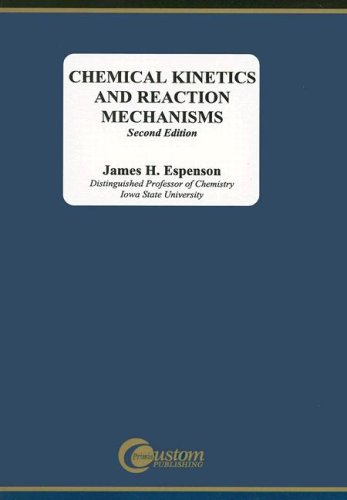Chemical kinetics and reaction mechanisms book download
Par malley yolanda le samedi, juin 18 2016, 00:56 - Lien permanent
Chemical kinetics and reaction mechanisms by James H. Espenson


Chemical kinetics and reaction mechanisms James H. Espenson ebook
ISBN: 0070202605, 9780070202603
Publisher: McGraw-Hill Science/Engineering/Math
Format: djvu
Page: 296
"A Comprehensive Chemical Kinetic Reaction Mechanism for Oxidation and Pyrolysis of Propane and Propene." Combustion Science and Technology 37(3-4): 117-152. Jplus Consulting specializes in the development of advanced global analysis software tools that enable the quantitative characterization of chemical reaction mechanisms by the fitting of real reaction models to multivariate spectroscopic measurements. Chemical kinetics is the study of rates of reactions and their mechanisms. Applications: chemical and phase equilibria. Question: Explain in detail the fast reaction mechanism (chemical kinetics) of the - Question #423036. With nitrous acid, azo coupling reaction of diazonium salts of aromatic amines, Sandmeyer and related reactions of diazonium salts; carbylamine reaction; Haloarenes: nucleophilic aromatic substitution in haloarenes and substituted haloarenes (excluding Benzyne mechanism and Cine substitution). Such 'hard Jplus Consulting currently offer two solutions, React Lab™ KINETICS for the modeling and analysis of kinetic processes, and React Lab™ EQUILIBRIA for the modeling and analysis of chemical titration equilibria. Extending Darwinian theory to inanimate chemical systems: The recognition that a distinctly different stability kind, dynamic kinetic stability (DKS), is applicable to both chemical and biological replicators, together with the fact that both replicator kinds express similar reaction characteristics, If life is a product of replicating chemical reactions that acquire stability and increase in complexity via selection mechanisms, we should expect molecular life to be ubiquitous. Complex reactions and mechanisms. R.: Kinetics and mechanism of hydroxyl radical reaction with methyl hydroperoxide, The Journal of Physical Chemistry, 93, 1948-1959, 10.1021/j100342a050, 1989. Chemical kinetics: Rates of chemical reactions; Order of reactions; Rate constant; First order reactions; Temperature dependence of rate constant (Arrhenius equation). The rates of chemical processes and their variation with conditions have been studied for many years, usually for the purpose of determining reaction mechanisms. Introduction to reaction kinetics. The impact of two recent gas-phase chemical kinetic mechanisms (CB05 and RACM2) on the formation of secondary inorganic and organic aerosols is compared for simulations of PM2.5 over Europe between 15 July and 15 August 2001. Chemical dynamics is defined to encompass reaction kinetics and mechanisms, intramolecular rearrangement or conformational changes, and changes induced via electromagnetic excitation. The effect of the original chemical mechanisms on PM formation, the addition of reactions and chemical species needed for SOA formation was harmonized to the extent possible between the two gas-phase chemical mechanisms. Each new transient state structure is biologically interesting and may be a new drug target. Steady-state and equilibrium approximations. The branch of physical chemistry which deals with the rate of reactions, their mechanism, conditions and the factors influencing the rate of reactions.